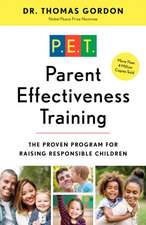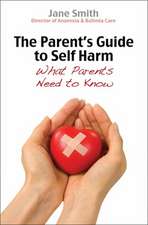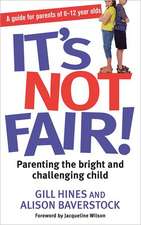How to Say No to Your Toddler: Creating a Safe, Rational, and Effective Discipline Program for Your 9-Month to 3-Year Old
Autor William G. Wilkoffen Limba Engleză Paperback – 30 sep 2003
For many parents of toddlers, saying “no” over and over becomes a mantra for exhaustion. Why is it so difficult to convey the meaning of this tiny word? Because, says pediatrician Will Wilkoff, when it comes to tots, actions speak louder than words.
Using very direct and simple guidelines, Dr. Wilkoff shows you how to develop a consistent and effective discipline plan. He explains what can go wrong with time-out and how to overcome obstacles, including your child’s rebelliousness, physical space issues, and your own reluctance. He also presents helpful advice for special situations, such as how to say no at meal times, at grandma’s house, and when your child is sick.
Presenting his compassionate and practical approach, Dr. Wilkoff shows how you can respond to the misbehavior of very young children while teaching them self-control that will benefit them throughout their lives. How to Say No to Your Toddler is the ideal guide for any parent who wants to take a more effective approach for raising healthy, happy children.
Preț: 94.47 lei
Nou
Puncte Express: 142
Preț estimativ în valută:
18.08€ • 18.92$ • 14.96£
18.08€ • 18.92$ • 14.96£
Carte disponibilă
Livrare economică 17-31 martie
Preluare comenzi: 021 569.72.76
Specificații
ISBN-13: 9780767912747
ISBN-10: 0767912748
Pagini: 240
Dimensiuni: 134 x 205 x 14 mm
Greutate: 0.19 kg
Editura: HARMONY
ISBN-10: 0767912748
Pagini: 240
Dimensiuni: 134 x 205 x 14 mm
Greutate: 0.19 kg
Editura: HARMONY
Notă biografică
A pediatrician for more than twenty-five years, WILL WILKOFF, M.D., is the author of three previous books (most recently The Three-Month Breastfeeding Guide) and has promoted his parenting strategies on national television, including “20/20” and “The Today Show.” Dr. Wilkoff lives and practices in Brunswick, Maine.
Extras
Chapter 1
The Importance of NO
Do I Need THIS BOOK?
We arrive at the threshold of parenting with our own unique collection of strengths and vulnerabilities. All children are not cut from the same cloth, and each of us must adopt a parenting style that is appropriate for our child's age and personality. The possible combinations of child temperaments and parental personalities are so numerous that no author can claim to offer advice that will work in every situation, or a strategy that every parent will find appealing.
However, during my thirty years as a general pediatrician working with thousands of families, I have noticed that the parents who are successful at managing their children's inevitable misbehaviors have one thing in common. Whether they be lobstermen or college professors, they discover how to say "No" while their children are still toddlers. It wasn't always easy. They shared their struggles with me and together we worked out the solutions. Here are a few of their most frequently encountered scenarios. If some of them sound familiar, then you will find the answers you are looking for in this book.
When I say "No" my toddler laughs and runs away. You have been playing games with your child for months. Now he has to learn that there are situations when you mean business.
My partner and I disagree on how we should respond when our child misbehaves. Consistency is an important element in managing your child's behavior. However, it is only natural that sometimes the two of you will disagree about discipline. There are several ways to incorporate these expected inconsistencies into your approach to parenting.
Our daycare provider complains that our child is being too aggressive. If his behavior doesn't improve, we may be asked to find another daycare. In this era when two-earner families have become the norm, behavior management is not just something to be done at home. There are simple solutions to this complex issue.
I find myself screaming at my toddler to get him to behave. It seldom works and I don't like the way I sound. You can learn to use your words and your actions to manage your child's misbehaviors without raising your voice.
I'm embarrassed to admit that I have smacked my child's hand to stop a behavior. You knew it was a mistake the moment you did it, but under the circumstances you felt you were out of options. There are ways to change the circumstances and there are other, safer strategies that work.
I have read that I should be redirecting my toddler and providing positive reinforcement for his good behavior, but I've tried and he continues the same misbehaviors. While these two strategies can be components of a successful behavior management plan, without a coexisting set of consequences for misbehavior they are seldom effective. This book will show you how to draw age-appropriate limits and administer safe, humane, and effective consequences.
We've tried time-out, but it didn't work. Time-out still remains the safest and most effective way to discourage your child's misbehaviors, but many parents, like yourselves, must learn the fine points of the process before it will be effective.
I've listened to some parents who try to talk their child into behaving properly. These discussions sound silly and don't stop the misbehavior. It is very important to talk to your child and consider the motivations for his behaviors, but eventually you must stop discussing the situation and take action. There are safe and humane ways of moving beyond the words when the situation demands action.
Our child seems to come by her good behavior naturally, but we want to be prepared for the time when she begins to test us. You may have been blessed with a child who--for the moment--seems to require neither limits nor consequences. But, as you suspect, the bubble will burst someday. This step into the real world will be much easier if you already have a plan.
This book does not dictate a monolithic plan that must be followed in painful detail from A to Z to achieve success. It is a collection of observations gathered over thirty years of watching thousands of parents succeed and fail at behavior management. I have arranged its chapters in what I consider to be a logical sequence, but you are encouraged to jump around and read the chapters that sound most appropriate first.
Whether it be the employment of earlier bedtimes, setting more age-appropriate limits, or learning how to use time-out, I am sure you will find the ingredients from which you can create an effective behavior management strategy that will fit your family's unique situation.
I have tried to keep this book short enough to be read in one or two evenings. From experience, I know that some chapters will need to be reread several times as new challenging behaviors erupt. I hope you find what I have to say helpful. If you do, please share what you have learned with other parents. Raising children is hard work and we all need a little encouragement from time to time.
Behavioral realist or realistic behaviorist? A book reviewer once described me as a behaviorist, and I guess if I were forced to crawl into a well-recognized psychological niche, the sign over the pigeonhole would read "Behavioral Therapist." I believe that we can mold behavior with positive and negative reinforcement, but if I could choose my own label, I would prefer to be known as a "Realist."
What you will read in this book is not based on theory, but on real world experiences. The most valuable portion of my education in child psychology began during my last year in medical school, when the first of our three children was born. Over the next thirty years, as I watched her and more than five thousand other children grow into adulthood, I observed what worked and what didn't work for my wife and myself and the other parents who were kind enough to share their experiences with me. I understand the challenges of parenting a toddler from firsthand experience. I won't ask you to make changes in your style that I haven't tried myself or seen other parents use successfully. I have realistic expectations for what you can accomplish, just as I want you to have realistic expectations for your child's behavior. You can be sure that although my advice may have a behavioral flavor it will always be realistic.
Now Is the Time to Learn How to Say "No!"
It isn't too early. Your toddler has been capable of understanding that "No" means "Stop that behavior!" since he was at least nine months old and probably long before that. But like many parents, you may have been reluctant to give him credit for understanding your admonitions. After all, he's only a baby.
On the other hand, you may have been far more lenient in interpreting his ability to grasp your encouraging words. You have been talking to your baby from the first moment you saw his heart beating on a sonogram. You had been asking him questions, telling him stories, and sharing your emotions with him for many months before you saw an obvious response flicker across his face.
Although you may have erroneously given him credit for a grin before he was a week old, by six weeks of age he was definitely smiling in response to your foolish chortling. When he was two or three months old your antics could trigger a hearty belly laugh, and by his sixth month your interactions had risen to the level of mimicking each other's lip-rattling "raspberries." These were true, but often wordless, conversations. Each of you expected and received a response to the sounds you were making. These little chats were all very happy and positive, but they formed the foundation for more serious communications that were to come. Even when he was six months old your child could draw associations between what you said, how you said it, and what was going to happen next.
Now that your little baby has "grown legs" and has begun looking for adventure, he is not too young to understand that when you say a particular word (e.g., "No") with a certain tone in your voice, he can expect negative consequences. Your toddler or even your creeping nine-month-old is pretty smart. If chicks can learn to peck at colored lights in complex sequences and rats can run mazes without a false step, your one-year-old is more than capable of understanding what you mean when you say "No." He may have already demonstrated that he understands its meaning by saying "No" himself in response to most of your questions. The process of attaching words to consequences is simple. Unfortunately, applying it to your young child's behavior isn't always easy, and that is why I have written this book.
And, it certainly isn't too late. Although I have chosen to include the word "toddler" in the title of this book, How to Say No . . . contains strategies and principles that can be applied to children who are in preschool. Even if you have been inconsistent in how and when you have been saying "No" for years, there is still time to learn how to use the word effectively.
If your child is between ages one and five he is still very adaptable, and you will discover that success can come in just a matter of days, weeks at the longest. In fact I have spoken with scores of parents of four- and five-year-olds who have noticed significant improvement overnight after making one or two simple changes in their approach to behavior management. It is never too late to change your behavior and the way you talk with your child so that he knows that you mean what you say.
But it gets harder the longer you wait. Compared to adolescence, the toddler years are far less complex. The situations in which you must say "No" to your two-year-old are pretty simple. "Don't run into the street!" "Don't play with the computer cords!" "Don't climb up on the kitchen counter!" The hazards in the life of a toddler are very real and the consequences of some of his misbehaviors every bit as serious as drinking and driving or unprotected sex, but when your child is two you don't have to compete with the powerful forces of peer pressure or the hormone-driven sexual curiosity of puberty.
For one thing, your toddler only weighs twenty-five or thirty pounds. You can pick him up and move him to a safer environment, and although it may leave you breathless, you can still outrun him. For the moment, you have some physical control over his behavior and the safety of his environment. By the time he reaches junior high, if not long before, you will need to rely more heavily on your ability to communicate with words alone. If you have a good track record of consistency that began when he was a toddler, your words will be much more effective when he is a teenager.
While it may sound far-fetched to speak about adolescent misbehavior and toddler mischievousness in the same breath, it's not. If your two-year-old has learned that he can trust what you say now and that he can believe your promises as well as your threats, you will have less trouble communicating with him when he gets older and the issues have become more complex. Don't get me wrong, I can't guarantee that if you read this book you won't have any trouble talking to your teenager. But I am sure that if you haven't mastered the ability to say "No" to your toddler in a way that he can understand, adolescence will be far more difficult than it needs to be . . . for both of you.
Safety is the bottom line. While none of us wants to be thought of as the parent of a "spoiled brat," it is your child's safety and not his reputation that is the most compelling reason to learn to say "No" to your toddler now. Of course he might learn that oven doors can burn his hands and electric cords can shock him through a process of trial and error, but I'm sure you would prefer that your child learn about these dangers and arrive at adulthood without the scars of his failed experiments.
Getting organized
As you explore the chapter headings, you may notice that the parts of behavior management parents find the most difficult, such as administering consequences, are presented last. The rationale for this arrangement goes beyond mere procrastination. Many misbehaviors can be tempered, avoided, or completely eliminated by careful attention to their causes and the situations in which they erupt. This means that by making some rather simple and easily achieved changes in your day-to-day family routines you may never need to administer the more dramatic consequences that most parents find so challenging.
This is why we will start with a bit of introspection about why "No" is such a difficult word to say. Then you and I will walk around your child's environment searching for the causes of her misbehaviors. At the same time we will be asking ourselves what role you may be playing in their occurrence. As a first step in preventing them we will prioritize her misbehaviors to make the job easier.
Next I will give you a blueprint from which you can build a discipline boundary that will be appropriate for your child's developmental stage and temperament. This limit-setting process will continue throughout her childhood, and like your own home it will need to be remodeled from time to time to meet the changing needs of your family.
With these limits in place we will look at the menu of responses at your disposal. I will describe why, over the course of thirty years of watching children and their parents, time-out has emerged as the safest and most effective consequence. We will explore the reasons that it may not have worked for you in the past and then give it another try with a few important changes.
The rest of the book is the icing on the cake. We will look at topics like the fine points of making threats, managing misbehaviors when you aren't at home, and what to do when you have issued a threat you couldn't keep. The last chapter contains a list of scenarios in which you will see how the basic principles of behavior management we have discussed can be applied to real-life toddler misbehaviors.
Boys will be boys, but . . . It is clear to those of us who are surrounded by children day in and day out that little boys usually present more disciplinary challenges than little girls. Clinical researchers have found that boys in general are more noncompliant. Unfortunately, these observations are of no consolation to the parents of a three-year-old girl who doesn't seem to understand when they tell her "No."
The Importance of NO
Do I Need THIS BOOK?
We arrive at the threshold of parenting with our own unique collection of strengths and vulnerabilities. All children are not cut from the same cloth, and each of us must adopt a parenting style that is appropriate for our child's age and personality. The possible combinations of child temperaments and parental personalities are so numerous that no author can claim to offer advice that will work in every situation, or a strategy that every parent will find appealing.
However, during my thirty years as a general pediatrician working with thousands of families, I have noticed that the parents who are successful at managing their children's inevitable misbehaviors have one thing in common. Whether they be lobstermen or college professors, they discover how to say "No" while their children are still toddlers. It wasn't always easy. They shared their struggles with me and together we worked out the solutions. Here are a few of their most frequently encountered scenarios. If some of them sound familiar, then you will find the answers you are looking for in this book.
When I say "No" my toddler laughs and runs away. You have been playing games with your child for months. Now he has to learn that there are situations when you mean business.
My partner and I disagree on how we should respond when our child misbehaves. Consistency is an important element in managing your child's behavior. However, it is only natural that sometimes the two of you will disagree about discipline. There are several ways to incorporate these expected inconsistencies into your approach to parenting.
Our daycare provider complains that our child is being too aggressive. If his behavior doesn't improve, we may be asked to find another daycare. In this era when two-earner families have become the norm, behavior management is not just something to be done at home. There are simple solutions to this complex issue.
I find myself screaming at my toddler to get him to behave. It seldom works and I don't like the way I sound. You can learn to use your words and your actions to manage your child's misbehaviors without raising your voice.
I'm embarrassed to admit that I have smacked my child's hand to stop a behavior. You knew it was a mistake the moment you did it, but under the circumstances you felt you were out of options. There are ways to change the circumstances and there are other, safer strategies that work.
I have read that I should be redirecting my toddler and providing positive reinforcement for his good behavior, but I've tried and he continues the same misbehaviors. While these two strategies can be components of a successful behavior management plan, without a coexisting set of consequences for misbehavior they are seldom effective. This book will show you how to draw age-appropriate limits and administer safe, humane, and effective consequences.
We've tried time-out, but it didn't work. Time-out still remains the safest and most effective way to discourage your child's misbehaviors, but many parents, like yourselves, must learn the fine points of the process before it will be effective.
I've listened to some parents who try to talk their child into behaving properly. These discussions sound silly and don't stop the misbehavior. It is very important to talk to your child and consider the motivations for his behaviors, but eventually you must stop discussing the situation and take action. There are safe and humane ways of moving beyond the words when the situation demands action.
Our child seems to come by her good behavior naturally, but we want to be prepared for the time when she begins to test us. You may have been blessed with a child who--for the moment--seems to require neither limits nor consequences. But, as you suspect, the bubble will burst someday. This step into the real world will be much easier if you already have a plan.
This book does not dictate a monolithic plan that must be followed in painful detail from A to Z to achieve success. It is a collection of observations gathered over thirty years of watching thousands of parents succeed and fail at behavior management. I have arranged its chapters in what I consider to be a logical sequence, but you are encouraged to jump around and read the chapters that sound most appropriate first.
Whether it be the employment of earlier bedtimes, setting more age-appropriate limits, or learning how to use time-out, I am sure you will find the ingredients from which you can create an effective behavior management strategy that will fit your family's unique situation.
I have tried to keep this book short enough to be read in one or two evenings. From experience, I know that some chapters will need to be reread several times as new challenging behaviors erupt. I hope you find what I have to say helpful. If you do, please share what you have learned with other parents. Raising children is hard work and we all need a little encouragement from time to time.
Behavioral realist or realistic behaviorist? A book reviewer once described me as a behaviorist, and I guess if I were forced to crawl into a well-recognized psychological niche, the sign over the pigeonhole would read "Behavioral Therapist." I believe that we can mold behavior with positive and negative reinforcement, but if I could choose my own label, I would prefer to be known as a "Realist."
What you will read in this book is not based on theory, but on real world experiences. The most valuable portion of my education in child psychology began during my last year in medical school, when the first of our three children was born. Over the next thirty years, as I watched her and more than five thousand other children grow into adulthood, I observed what worked and what didn't work for my wife and myself and the other parents who were kind enough to share their experiences with me. I understand the challenges of parenting a toddler from firsthand experience. I won't ask you to make changes in your style that I haven't tried myself or seen other parents use successfully. I have realistic expectations for what you can accomplish, just as I want you to have realistic expectations for your child's behavior. You can be sure that although my advice may have a behavioral flavor it will always be realistic.
Now Is the Time to Learn How to Say "No!"
It isn't too early. Your toddler has been capable of understanding that "No" means "Stop that behavior!" since he was at least nine months old and probably long before that. But like many parents, you may have been reluctant to give him credit for understanding your admonitions. After all, he's only a baby.
On the other hand, you may have been far more lenient in interpreting his ability to grasp your encouraging words. You have been talking to your baby from the first moment you saw his heart beating on a sonogram. You had been asking him questions, telling him stories, and sharing your emotions with him for many months before you saw an obvious response flicker across his face.
Although you may have erroneously given him credit for a grin before he was a week old, by six weeks of age he was definitely smiling in response to your foolish chortling. When he was two or three months old your antics could trigger a hearty belly laugh, and by his sixth month your interactions had risen to the level of mimicking each other's lip-rattling "raspberries." These were true, but often wordless, conversations. Each of you expected and received a response to the sounds you were making. These little chats were all very happy and positive, but they formed the foundation for more serious communications that were to come. Even when he was six months old your child could draw associations between what you said, how you said it, and what was going to happen next.
Now that your little baby has "grown legs" and has begun looking for adventure, he is not too young to understand that when you say a particular word (e.g., "No") with a certain tone in your voice, he can expect negative consequences. Your toddler or even your creeping nine-month-old is pretty smart. If chicks can learn to peck at colored lights in complex sequences and rats can run mazes without a false step, your one-year-old is more than capable of understanding what you mean when you say "No." He may have already demonstrated that he understands its meaning by saying "No" himself in response to most of your questions. The process of attaching words to consequences is simple. Unfortunately, applying it to your young child's behavior isn't always easy, and that is why I have written this book.
And, it certainly isn't too late. Although I have chosen to include the word "toddler" in the title of this book, How to Say No . . . contains strategies and principles that can be applied to children who are in preschool. Even if you have been inconsistent in how and when you have been saying "No" for years, there is still time to learn how to use the word effectively.
If your child is between ages one and five he is still very adaptable, and you will discover that success can come in just a matter of days, weeks at the longest. In fact I have spoken with scores of parents of four- and five-year-olds who have noticed significant improvement overnight after making one or two simple changes in their approach to behavior management. It is never too late to change your behavior and the way you talk with your child so that he knows that you mean what you say.
But it gets harder the longer you wait. Compared to adolescence, the toddler years are far less complex. The situations in which you must say "No" to your two-year-old are pretty simple. "Don't run into the street!" "Don't play with the computer cords!" "Don't climb up on the kitchen counter!" The hazards in the life of a toddler are very real and the consequences of some of his misbehaviors every bit as serious as drinking and driving or unprotected sex, but when your child is two you don't have to compete with the powerful forces of peer pressure or the hormone-driven sexual curiosity of puberty.
For one thing, your toddler only weighs twenty-five or thirty pounds. You can pick him up and move him to a safer environment, and although it may leave you breathless, you can still outrun him. For the moment, you have some physical control over his behavior and the safety of his environment. By the time he reaches junior high, if not long before, you will need to rely more heavily on your ability to communicate with words alone. If you have a good track record of consistency that began when he was a toddler, your words will be much more effective when he is a teenager.
While it may sound far-fetched to speak about adolescent misbehavior and toddler mischievousness in the same breath, it's not. If your two-year-old has learned that he can trust what you say now and that he can believe your promises as well as your threats, you will have less trouble communicating with him when he gets older and the issues have become more complex. Don't get me wrong, I can't guarantee that if you read this book you won't have any trouble talking to your teenager. But I am sure that if you haven't mastered the ability to say "No" to your toddler in a way that he can understand, adolescence will be far more difficult than it needs to be . . . for both of you.
Safety is the bottom line. While none of us wants to be thought of as the parent of a "spoiled brat," it is your child's safety and not his reputation that is the most compelling reason to learn to say "No" to your toddler now. Of course he might learn that oven doors can burn his hands and electric cords can shock him through a process of trial and error, but I'm sure you would prefer that your child learn about these dangers and arrive at adulthood without the scars of his failed experiments.
Getting organized
As you explore the chapter headings, you may notice that the parts of behavior management parents find the most difficult, such as administering consequences, are presented last. The rationale for this arrangement goes beyond mere procrastination. Many misbehaviors can be tempered, avoided, or completely eliminated by careful attention to their causes and the situations in which they erupt. This means that by making some rather simple and easily achieved changes in your day-to-day family routines you may never need to administer the more dramatic consequences that most parents find so challenging.
This is why we will start with a bit of introspection about why "No" is such a difficult word to say. Then you and I will walk around your child's environment searching for the causes of her misbehaviors. At the same time we will be asking ourselves what role you may be playing in their occurrence. As a first step in preventing them we will prioritize her misbehaviors to make the job easier.
Next I will give you a blueprint from which you can build a discipline boundary that will be appropriate for your child's developmental stage and temperament. This limit-setting process will continue throughout her childhood, and like your own home it will need to be remodeled from time to time to meet the changing needs of your family.
With these limits in place we will look at the menu of responses at your disposal. I will describe why, over the course of thirty years of watching children and their parents, time-out has emerged as the safest and most effective consequence. We will explore the reasons that it may not have worked for you in the past and then give it another try with a few important changes.
The rest of the book is the icing on the cake. We will look at topics like the fine points of making threats, managing misbehaviors when you aren't at home, and what to do when you have issued a threat you couldn't keep. The last chapter contains a list of scenarios in which you will see how the basic principles of behavior management we have discussed can be applied to real-life toddler misbehaviors.
Boys will be boys, but . . . It is clear to those of us who are surrounded by children day in and day out that little boys usually present more disciplinary challenges than little girls. Clinical researchers have found that boys in general are more noncompliant. Unfortunately, these observations are of no consolation to the parents of a three-year-old girl who doesn't seem to understand when they tell her "No."

















